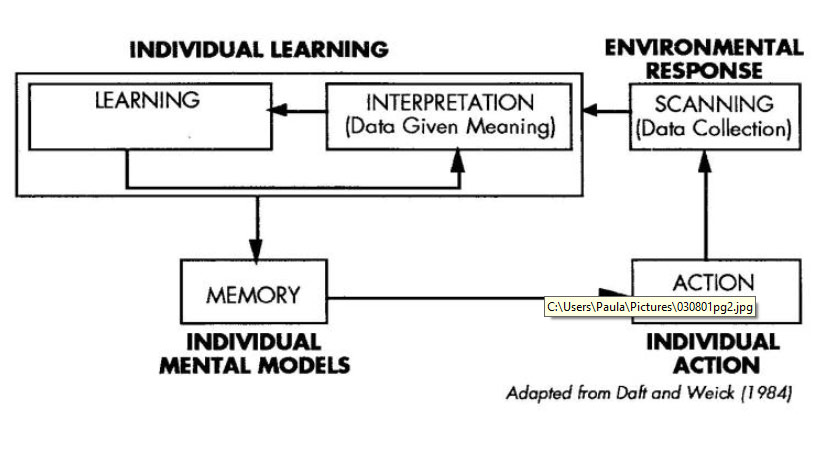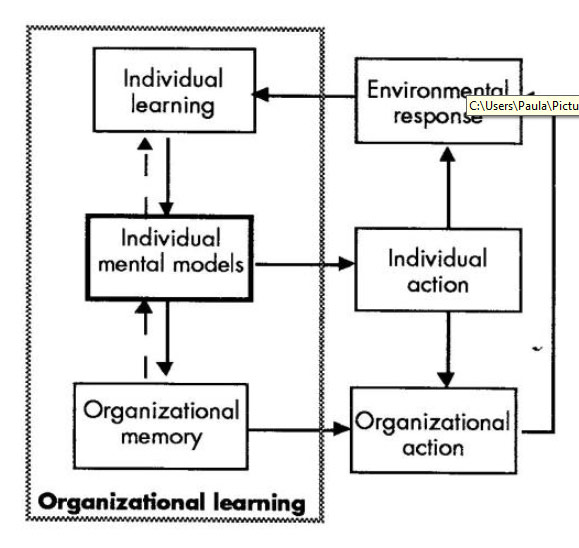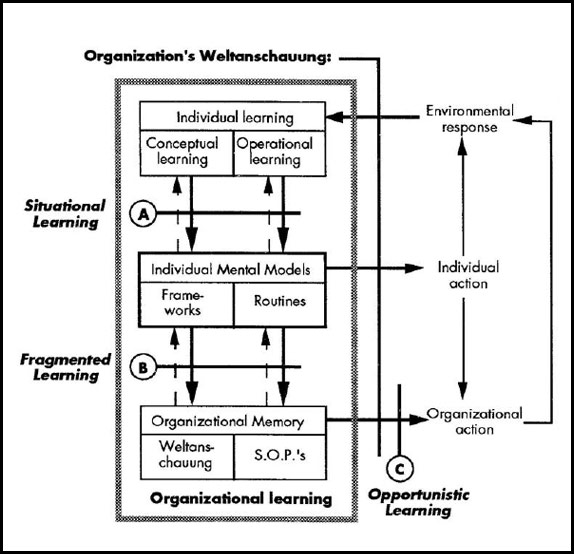Imagine an organization in which all the records disintegrated overnight. Suddenly, there are no more reports, no computer files, no employee records, no operating manuals, no calendars—all that remain are the people, buildings, capital equipment, raw materials, and inventory. Now imagine an organization where all of the people have mysteriously disappeared. The organization is left intact in every other way, but they are no employees. Which organization will find it easier to rebuild its former status, to continue to take actions, and to learn?
One may be tempted to conclude that substituting new people would be easier than replacing all the information and systems. But even in the most bureaucratic organization, with all its standard operating procedures and established protocols, there is much more about the firm that is unsaid and unwritten. In fact, numerical and verbal databases only capture a small fraction of the information that is in mental “databases.”
The essence of an organization is embodied in its people, not its systems. The intangible assets of a company reside in the individual mental models that contribute to the organization’s memory. Without these mental models—which include the subtle interconnections that have been developed among the members—an organization will be incapacitated in both learning and action. Yet in most organizations, individual mental databases are not “backed up,” nor is the transfer from individual to organizational learning well managed. A critical challenge for a learning organization is understanding the transfer process through which individual learning and knowledge (mental models) become embedded in an organization’s memory and structure. Once we have a clear understanding of this transfer process, we can actively manage organizational learning to be consistent with an organization’s goals, vision, and values.
“The essence of an organization is embodied in its people, not its systems. The intangible assets of a company reside in individual mental models…”
From Individual Learning…
In order to develop a framework for organizational learning, we must begin by understanding how individuals learn. The “Individual Learning Cycle” diagram shows a simplified model of individual learning. The diagram traces the process through which the brain assimilates some new data (environmental response), takes into account the memories of past experiences, comes to some conclusion about the new piece of information (individual learning), and then stores it away (individual mental models). After processing the new learning, one may choose to act or simply do nothing (individual action).
The processing stage has been labeled “individual mental models” because it represents much more than the traditional concept of memory. Memory connotes a rather static repository for knowledge, whereas mental models involve the active creation of new knowledge. Mental models represent a person’s view of the world, including both explicit and implicit understandings. They also provide the context in which to view and interpret new material, and they determine how stored information will be applied to a given situation.
…To Organizational Learning
In the early stages of an organization’s existence, organizational learning is often synonymous with individual learning since it usually involves a very small group of people and the organization has minimal structure. As an organization grows, however, a distinction between the two levels of learning emerges. Somewhere in that process, a system evolves for capturing learnings from its individual members.
There is little agreement on what constitutes “appropriate” learning—those individual actions or learnings that should be transferred from the individual into the organization’s memory. Standard operating procedures (SOP’s), for example, are viewed as an important part of an organization’s memory—a repository of past learning. But SOP’s can also be a roadblock to learning if an organization becomes locked into old procedures and avoids searching for entirely new modes of behavior. How does an organization decide when once-appropriate routines are no longer valid? Can an organizational anticipate obsolescence of its SOPs or must it always learn by first making inappropriate decisions in the face of changing conditions? These are the types of issues which a model of organizational learning must address.
Organizational Learning Cycles
By extending our model of individual learning to include organizational learning, we can begin to explore the transfer process between the two (see “A Simple Model of Organizational Learning”). This model represents the organizational learning cycle as a four-stage process, with organizational learning composed of three distinct sub-stages: individual learning, individual mental models, and organizational memory. Individual actions are taken based on individual mental models. These actions, in turn, translate into organizational action, and both actions produce some environmental response. The cycle is complete when the environmental response, in turn, leads to individual learning and affects individual mental models and organizational memory.
Individual Learning Cycle

This simple model captures the transfer of individual learning to organizational memory via changes in individual mental models. Thus, organizational learning is separated from action (because all learning does not translate into taking new actions) and from environmental response (because all learning is not precipitated by the environment). The complete learning cycle, however, does include both the actions of the individual and the organization as well as the environmental response to those actions.
An Integrated Model
There are at least two fundamentally different levels of learning at which an organization must be equally adept—operational and conceptual. Operational learning deals with the changes in the way we actually do things–filling out entry forms, operating a piece of machinery, handling a switchboard, retooling a machine, etc. While operational learning emphasizes the how of doing things, conceptual learning, emphasizes the why of doing things—that is, it has do with the thinking behind why things are done in the first place. Conceptual learning deals with issues that challenge the very nature or existence of prevailing conditions or procedures. In order for organizational learning to be effective, however, conceptual learning must be operationalized into specific skills that can be learned and executed.
Individual Mental Models: Frameworks and Routines. Individual learning is captured in mental models through two different paths (see “Organizational Learning: An Integrated Model”). Operational learning produces new or revised routines that replace old or outworn ones. Conceptual learning leads to changes in frameworks, leading to new ways of looking at the world and new actions. For example, a design engineer may follow a six-step process for getting her drawings ready for a program review meeting. Through experience, she may learn to improve the process by stream-lining some of the steps involved (operational learning). As she rethinks the framework of her work—the context in which the drawings are being produced and what their use is—she may question the production of the drawings themselves and identify situations when the drawings may not be necessary (conceptual learning). Her revised mental models will contain both the new frameworks and routines as well as the knowledge about how the routines fit within the new framework.
Organizational Memory: Weltanschauung and SOP’s. The dual pathway continues from mental models to organizational memory. Over time, individual mental frameworks become embedded into the organization’s own weltanschauung, or worldview. An organization’s view of the world, in turn, affects how the individual interprets changes in the environment and how she translates her mental models into action. It also influences how the organization translates its organizational memory into action. For example, if an organization believes its ability to affect the environment is low, it will rely on standard routines and reactive behaviors. If, on the other hand, an organization assumes that it can take an active role in affecting its environment, this organization may approach everything in the spirit of experimentation, testing, and inventing.
In similar fashion, individual routines that are proven sound over time become a company’s standard operating procedures. The strength of the link between individual mental models and organizational memory depends how influential an individual or group is. In the case of a CEO or upper management, influence can be high due to the power inherent in the positions. Similarly, a united group of hourly workers can have a high degree of influence due to their size.
Incomplete Learning Cycles
Organizational learning requires completing the entire loop. If any of the links are either weak or broken, learning can be impaired. Situational learning, for example, occurs when the link between individual learning and individual mental models is severed: that is, the learning is situation-specific and does not change mental models. Crisis management is one example of situational learning in which each problem is solved but no learning is carried over to the next case.
When the link between individual models and organizational memory is broken, fragmented learning occurs. Individual mental models may change, but those changes are not reflected in the organization’s memory. When organizational learning is fragmented among isolated individuals (or groups), the loss of the individuals (through turnover or layoffs) means loss of knowledge as well.
The link between organizational memory and organizational action, if broken, can lead to opportunistic learning. This occurs when organizational actions are pursued without taking into account organizational memory or the organization’s values, culture, and SOP’s. Sometimes this is done purposely, when one wishes to bypass the features of an organization that may impede progress on a specific front. The use of “skunk works” to develop the IBM personal computer is a good example, as is General Motors’ creation of an entirely new car division, Saturn.
Managing the Whole Learning Cycle
Managing organizational learning means managing the complete cycle—explicitly. Improving each of the pieces is not enough—the links between the pieces must also be managed. This requires addressing each of the incomplete learning cycles described above.
Beyond Situational Learning.
Mental models are the critical pathway between individual learning and organizational memory. Mental models are the manager and arbiter of how new information will be acquired, retained, used, and deleted. Although a company can try to manage the flow of information, control the environment, or manipulate peoples’ learning environment in various ways, if a person’s view of the world remains unchanged, it is unlikely that any such actions will affect the quality of learning.
A Simple Model of Organizational Learning

Therefore, closing the loop on situational learning—the link between individual learning and individual mental models—requires developing individuals’ ability to transfer specific insights into more general maps that will guide them in the future. In order to make mental models explicit, we nerd appropriate tools to capture the type of knowledge that is being mapped.
Dynamic systems, in particular, require a different set of tools for making mental models explicit. Systems archetypes (systemic structures that recur repeatedly in diverse settings) such as “Shifting the Burden” and “Tragedy of the Commons” can be very helpful for eliciting and capturing managers’ intuitive understanding of complex dynamic issues. Action maps are also useful for capturing the behavioral dynamics of a team or organization over time. They help managers see the larger patterns of behavior in which their specific actions are embedded. Together, these two methods can help surface and capture a great deal of tacit individual knowledge in a way in which it can be shared, challenged, and subject to change—thus transferring it to organizational memory.
From Fragmented to Organizational Learning. Capturing individual mental models alone is not sufficient to achieve organizational learning, however. There also needs to be a way to prevent fragmented learning among individuals and to spread the learning throughout the organization. One way to accomplish this is through the design and implementation of learning laboratories—managerial practice fields where teams of managers can practice and learn together (see page 5).
Learning laboratories can be designed, in part, around the learnings captured in systems archetypes and action maps. The spirit of the learning lab is one of active experimentation and inquiry, where everyone participates in surfacing and testing each other’s mental models. Through this process, a shared understanding of the key assumptions and inter-relationships of the organization can emerge. The use of an interactive computer management flight simulator (see “Flying People Express Again,” V IN6) offers the participants an opportunity to test their assumptions and to viscerally experience the consequences of their actions. The learning laboratory can be the vehicle through which organizational memory—via its weltanschauung and SOP’s—can be enriched over time.
Organizational Learning: An Integrated Model

Harnessing Opportunistic Learning. If the organization’s own culture and ways of doing things get in the way of learning, scenario planning and idealized designs can provide a way to break out of the norms. Royal Dutch Shell uses scenario planning to create alternative realities that stretch beyond what most managers in the company are likely to envision. By carefully constructing a multiple set of possible scenarios, Shell has been successful in anticipating and adapting to extremely volatile environments (see “Scenario Planning: Managing by Foresight,” V IN7).
Idealized designs, used by Russell Ackoff and his colleagues at Interact (Bala Cynwood, PA), can also minimize the amount of influence an organization’s current state has in determining its future. The principle idea is to start by crystallizing an ideal future without considering the current capabilities or organizational limitations. Thus, the planning process is “pulled” by where you want to be instead of “anchored” by where you are.
The Learning Challenge
The old model of a hierarchical corporation where the top thinks and the bottom acts is giving way to a new model where thinking and acting must occur at all levels. As organizations push for flatter structures and reduced bureaucracy, there will be increased reliance on the individuals to be the carriers of the organization’s knowledge. Instead of codifying rules and procedures in handbooks and policy manuals, the new challenge is to continually capture the emerging understanding of the organization wherever it unfolds. At the heart of it all is understanding the role individual mental models play in the organizational learning cycle and continually finding ways to manage the transfer from individual to organizational learning.
Further reading: Daniel H. Kim, “Individual and Organizational Learning: Where the Twain Shall Meet?” System Dynamics Group Working Paper #D-4114 (MIT Sloan School of Management, Cambridge, MA) 1989.
